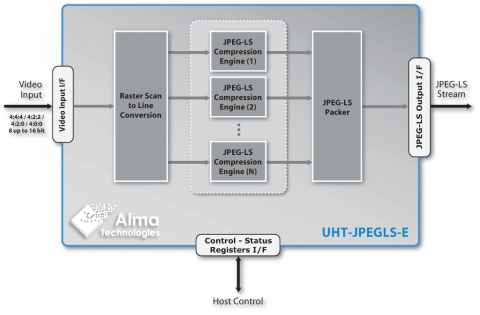You are here:

Scalable Ultra-High Throughput JPEG-LS Encoder
The UHT-JPEGLS-E core is a JPEG-LS encoder, compliant to ISO/IEC IS 14495-1 | ITU-T Recommendation T.87 standards. It supports encoding of 4:4:4, 4:2:2, 4:2:0 and 4:0:0 (grayscale) video streams, in 8 up to 16 bits sample depths. The core is a standalone and high-performance JPEG-LS encoder, designed for enabling ultra-high frame rate SD and HD encoding, and Ultra HD video encoding (4K/8K and beyond), even in low-end ASIC or FPGA silicon. The UHT-JPEGLS-E is available for ASIC or AMD-Xilinx, Efinix, Intel, Lattice and Microsemi FPGA and SoC based designs.
JPEG-LS is based on the LOCO-I (Low Complexity-Lossless Compression for Images) image compression algorithm, which uses a non-linear predictive scheme with rudimentary edge detecting capability, based on the four nearest –causal- neighbours (left, upper left, upper and upper right) and an entropy encoder using adaptively selective Golomb-type codes. The low complexity scheme of JPEG-LS is based on the assumption that prediction residuals follow a two-sided geometric distribution and the fact that Golomb-codes are optimal for geometric distributions, thus the modeling and coding units are matching.
UHT-JPEGLS-E is very easy to use and integrate in a system. It requires minimal host intervention as it only needs to be programmed once per video sequence. Once programmed, it can encode an arbitrary number of video frames without the need of any further intervention or assistance by the host system CPU.
UHT-JPEGLS-E accepts the uncompressed raw video data in interleaved scan format. It outputs standalone, standard compliant, JPEG-LS byte stream format. No post processing on the output stream, other than (as examples) saving, muxing, or transmitting, is required by the host. The output JPEG-LS byte stream can be decoded, as is, by any corresponding ISO/IEC IS 14495-1 | ITU-T Recommendation T.87 compliant decoder.
JPEG-LS is based on the LOCO-I (Low Complexity-Lossless Compression for Images) image compression algorithm, which uses a non-linear predictive scheme with rudimentary edge detecting capability, based on the four nearest –causal- neighbours (left, upper left, upper and upper right) and an entropy encoder using adaptively selective Golomb-type codes. The low complexity scheme of JPEG-LS is based on the assumption that prediction residuals follow a two-sided geometric distribution and the fact that Golomb-codes are optimal for geometric distributions, thus the modeling and coding units are matching.
UHT-JPEGLS-E is very easy to use and integrate in a system. It requires minimal host intervention as it only needs to be programmed once per video sequence. Once programmed, it can encode an arbitrary number of video frames without the need of any further intervention or assistance by the host system CPU.
UHT-JPEGLS-E accepts the uncompressed raw video data in interleaved scan format. It outputs standalone, standard compliant, JPEG-LS byte stream format. No post processing on the output stream, other than (as examples) saving, muxing, or transmitting, is required by the host. The output JPEG-LS byte stream can be decoded, as is, by any corresponding ISO/IEC IS 14495-1 | ITU-T Recommendation T.87 compliant decoder.
查看 Scalable Ultra-High Throughput JPEG-LS Encoder 详细介绍:
- 查看 Scalable Ultra-High Throughput JPEG-LS Encoder 完整数据手册
- 联系 Scalable Ultra-High Throughput JPEG-LS Encoder 供应商
Block Diagram of the Scalable Ultra-High Throughput JPEG-LS Encoder




